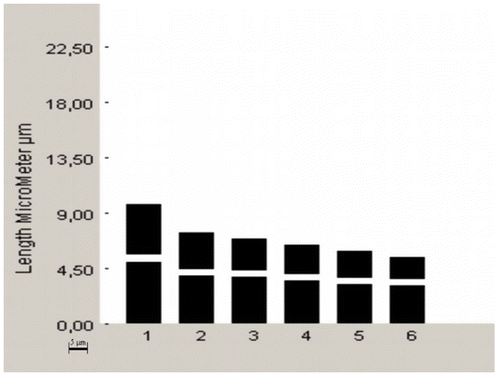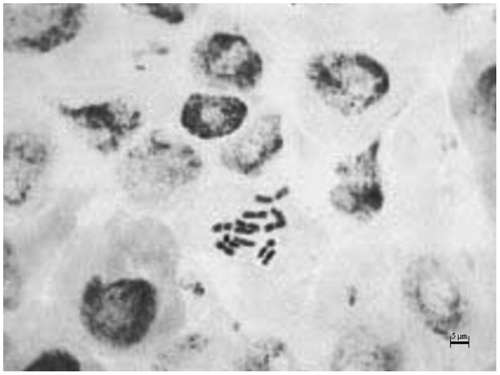Abstract
In this paper, the karyological properties of an endemic plant for Turkey, Matthiola anchoniifolia Hub.-Mor. grown in the Sivas Province in Turkey, are studied. Karyotype was made on somatic metaphases using an Image Analysis System. The somatic chromosome number is determined as 2n = 12. The karyotype formula of this species consists of five median chromosome pairs and one submedian chromosome pair. The shortest chromosome length is 4.89 μm, the longest is 9.18 μm, and haploid chromosome length is 38.66 μm. Photographs were taken using a BX51 Olympus microscope. An ideogram of the species was drawn using an Image Analysis System.
Keywords:
Introduction
Brassicaceae is represented worldwide by 365 genera and 3250 species and it is denoted as a huge family (Simpson Citation2006). The major centers of distribution of the family are in the Mediterranean, Irano-Turanian and Saharo-Sindian regions (Hedge Citation1976). In terms of the Brassicaceae family, Turkey is one of the richest countries, with 61 genera and 653 native species (Al-Shehbaz et al. Citation2007).
The genus Matthiola R.Br. (Brassicaceae) is distributed in Africa, Europe and Asia. This genus is represented by approximately 50 species in the world, with 10 species in Turkey (Cullen Citation1965; Heywood Citation1993; Dirmenci et al. Citation2006). Among the endemic taxa identified for Turkey there are: Matthiola anchonifolia Hub.-Mor., M. longipetala (Vent.) DC. subsp. pumilio (Sibht. & Smith) P.W. Ball, M. montana Boiss, and M. trojana T. Dirmenci, F. Satıl & G. Tümen (Ekim et al. Citation2000; Dirmenci et al. Citation2006). M. anchoniifolia is distributed in the Sivas Province in Turkey (Cullen, Citation1965). According to the Red data book of Turkish plants, M. anchoniifolia Hub.-Mor. is categorized as lower risk/conservation dependent (LR/cd) (Ekim et al. Citation2000).
Karyological research on the taxa of genus Matthiola R.Br. showed that diploid chromosome numbers were 2n = 10, 12, 14 and 16 (Dahlgren et al. Citation1971; Polatschek Citation1983; Soliman and Parker Citation1986; Izuzquiza Citation1989; Canzobre and Castroviejo Citation1993; Tiniakou Citation1996; Soliman Citation2002; Sánchez et al. Citation2004; Garbari et al. Citation2012).
In this study, the chromosome number and karyotype of M. anchoniifolia were determined for the first time.
Material and methods
For karyological study, the squash preparation method was used for chromosome study in this species. Karyotype was made on somatic metaphases using an Image Analysis System. This system is a modern and well-known software programme for making karyotype quickly. This programme is very famous programme and it is used to make karyotype faster than the other programmes. Root meristems from germinating seeds collected in the wild were used. Root tips were pretreated with α-monobromonaphthalene at 4°C for 16 h. Root tips were fixed with Carnoy’s solution for 24 h at 4°C. Before staining, the material was hydrolyzed with 1 N HCl for 12 minutes at room temperature. The chromosomes were stained with 2% acetic orcein and mounted in 45% acetic acid. Permanent slides were made by using the standard liquid nitrogen method. Photographs were captured using a digital camera (Olympus DP71, Tokyo, Japan) connected with a microscope (Olympus BX51 microscope, Tokyo, Japan) in Cumhuriyet University in Sivas. Chromosomes were classified using the nomenclature of Levan et al. (Citation1964).
Results
The karyotype of Matthiola anchoniifolia Hub.-Mor. (Brassicaceae) growing naturally in Turkey was analyzed in detail. The somatic chromosome number of Matthiola anchoniifolia was determined to be 2n = 12 (Figure ). The karyotype consisted of five pairs of median chromosomes and one pair of submedian chromosome. The shortest chromosome length is 4.89 μm, the longest is 9.18 μm, and haploid chromosome length is 38.66 μm. Chromosome arm ratios are measured as 1.22–1.74. Centromeric index varies between 4.62 and 10.68, and relative lengths vary from 12.65 to 23.74. An ideogram of the species was drawn by Image Analysis System (Figure ).
Discussion
The karyological study of Martin, Duran and Dirmenci (Citation2007) reported that Matthiola trojana T. Dirmenci, F. Satıl and G. Tümen had a diploid chromosome number as 2n = 12. The basic chromosome number of this species is x = 6. The karyotype of this species consisted of four pairs of median chromosome and two pairs of submedian chromosomes. Chromosome length is 2.44–4.27 μm. In our study the diploid chromosome number of M. trojana is 2n = 12, and the basic chromosome number is the same as M. anchoniifolia: x = 6. However, in our study the karyotype formula of M. anchoniifolia is 5m + 1sm, and the chromosome length is different from M. trojana. Another karyological study of Matthiola odoratissima (Pall.) R.Br. reported the somatic chromosome number as 2n = 12 (Martin, Duran, Ünal, et al. Citation2007). Like in our study, the basic chromosome number was x = 6. But karyotype formula and chromosome lengths in both species are different. In M. odoratissima the karyotype formula is 4m + 2sm. In M. odoratissima chromosome lengths are 2.85–6.06 μm, but in M. anchoniifolia they are 4.89–9.18 μm.
Total haploid chromosome lengths are defined in M. odoratissima as 25.10 μm, and in M. anchoniifolia as 38.66 μm. The somatic chromosome number of Matthiola montana Boiss. was reported, like in M. anchoniifolia, as 2n = 12 (Martin et al. Citation2011). But the karyotype formula and chromosome lengths in both species are different. In M. montana the karyotype formula is 4m + 2sm. In M. montana chromosome lengths are 1.85–4.25 μm; in M. anchoniifolia they are 4.89–9.18 μm. Total haploid chromosome lengths are defined in M. montana as 17.29 μm, and in M. anchoniifolia as 38.66 μm. The diploid chromosome number in Matthiola bolleana Webb ex Christ. was reported, like in M. anchoniifolia, as 2n = 12 (CitationArdévol-Gonzáles et al. 1993). Our chromosome number results are similar to the literature.
Cytological study in the genera of Matthiola, Erucaria, Cakile, and Eremobium belonging to Cruciferae family, the karyotypes of these taxa were reported (Soliman Citation2002). In this study, diploid chromosome numbers of Matthiola are as follows; in M. arabica 2n = 14, in Matthiola livida 2n = 10, 12 and in M. longipetala 2n = 12.
In our study, diploid chromosome numbers of M. anchoniifolia show similarity with the somatic chromosome numbers of other species. Soliman (Citation2002) carried out a karyological study of three species that belong to the genus Matthiola, and in these species somatic chromosome numbers were defined variously. In M. arabica the somatic chromosome number is 2n = 14, and the karyotype formula is formed from 2M, 4nm, 4nsm (–), 2 nsm (+) and 2nst (+) chromosome pairs. In M. livida the somatic chromosome number is 2n = 10, the karyotype formula is declared as 2M, 4nm and 4nsm (–) and 2n = 12 had 2M, 4nm and 6nsm (–). In M. longipetala the somatic chromosome number is 2n = 12 and the karyotype formula is 2M, 6nm, 2nsm (–) and 2nsm (4) (Soliman Citation2002). In our research, the somatic chromosome number of M. anchoniifolia is defined as 2n = 12 and the karyotype formula is 5m + 1sm. When we compare the total chromosome length of Matthiola species, we can see that there are some differences. For example, the total length of chromosomes in M. arabica is 15.00 μm, in M. livida it is 11.77 μm, in M. longipetala it is 15.66 μm, and in M. anchoniifolia it is 38.66 μm.
Karyological research on the Matthiola genus in Italy showed that diploid chromosome numbers were 2n = 12, 14 and 16 (Garbari et al. Citation2012). The diploid chromosome numbers of Matthiola carnica Tammaro, M. fruticulosa (L.) Maire, M. italica (Conti P.) Tammaro, M. valesiaca (J. Gay) Boisser var. pedamontana Gremli and M. valesiaca (J. Gay) Boissier were reported as 2n = 12. (Garbari et al. Citation2012). In the present study, the somatic chromosome number of M. anchoniifolia (2n = 12) is similar to those given in the literature (Garbari et al. Citation2012). For the other species diploid chromosome numbers were reported as 2n = 14 in M. incana (L.) R. Br. subsp. pulchella (Tin. ex Guss.) Brullo et Furnari, M. undulata Tineo, M. sinuata (L.) R. Br. and M. tricuspidata R. Br., and 2n = 16 in M. tristis L. var. sicula Conti. Our result (2n = 12) is different from the diploid chromosome number results (2n = 14, 16) (Garbari et al. Citation2012).
In conclusion, M. anchoniifolia chromosome number and karyotype were determined for the first time. We hope that this study will contribute to karyological studies of the genus Matthiola.
References
- Al-Shehbaz IA, Mutlu B, Dönmez AA. 2007. The Brassicaceae (Cruciferae) of Turkey. Updated. Turk J Bot. 31:327–336.
- Ardevol-Gonzales JF, Borgen L, Perez De Paz PL. 1993. Checklist of chromosome numbers counted in Canarian vascular plants. Sommerfeltia. 18:51–59.
- Canzobre E, Castroviejo S. 1993. Estudio citotaxonomia de la flora de las costas gallegas. Cadernos Ărea Ci Biol. 3:1–215.
- Cullen J. 1965. Matthiola R. Br. In: Davis PH, editors. Flora of Turkey and East Aegean Islands. vol 1. Edinburgh: Edinburgh University Press. p. 447–450.
- Dahlgren R, Karlsson Th, Lassen P. 1971. Studies on the flora of the Balearic Islands I. Chromosome numbers in Balearic Angiosperms. Botaniska Notiser. 124:249–269.
- Dirmenci T, Satıl F, Tümen G. 2006. A new species of Matthiola R. Br. (Brassicaceae) from Turkey. Bot J Linn Soc. 151:431–435.
- Ekim T, Koyuncu M, Vural M, Duman H, Aytaç Z, Adıguzel N. 2000. Red data book of Turkish plants. Ankara: Turkish Association for the Conservation of Nature.
- Garbari F, Bedini G, Peruzzi L. 2012. Chromosome numbers of the Italian flora. From the Caryologia foundation to present. Caryologia. 65 (1): 62–71.
- Hedge IC. 1976 A systematic and geographical survey of the old world Cruciferae. In: Vaughan JG, Macleod AJ, Jones BMG, editors. The biology and chemistry of the Cruciferae. London: Academic Press, p. 1-45.
- Heywood VH. 1993. Flowering plants of the world. New York: Oxford University Press. p. 67–69.
- Izuzquiza A. 1989. Números cromosomaticos de plantas occidentales 533–538. An Jard Bot Madrid. 45:509–513.
- Levan A, Fredga K, Sandberg AA. 1964. Nomenclature for centromeric position on chromosomes. Hereditas. 52(2):201–220.
- Martin E, Akçiçek E, Çetin Ö, Duran A. 2011. Cytogenetical analysis of endemic Matthiola montana (Goldlack) from Turkey. Biodicon. 4(1):187–191.
- Martin E, Duran A, Dirmenci T. 2007. Karyotype of Matthiola trojana (Brassicaceae), a recently described endemic from Turkey. Int J Bot. 3(2):222–225.
- Martin, E, A Duran, M Ünal, A. Özdemir 2007. A karyological study on Matthiola odoratissima (Pall.) R. Br. of the family Cruciferae in Turkey. International Conference on Environment: Survival and Sustainability, Abstracts, Vol:2, p. 621, 19-24 February 2007, Near East University, Nicosin, Turkish Republic of Northern Cyprus.
- Polatschek A. 1983. Chromosomenzahlen und hinweise auf systematik und verbreitung von Brasicaceae-arten aus Europa, Nordafrika, Asien und Australien. Phyton. 23:127–139.
- Sanchez JL, Reyes-Betancort JA, Scholz S, Caujape-Castells J. 2004. Patrones de Variaciŏn genetica poblacional en el endemismo canario Matthiola bolleana Webb ex Christ. Bot Macaroněsica. 25:3–13.
- Simpson, MG. 2006. Plant systematics. 1st ed. San Diego (CA): Elsevier Academic Press.
- Soliman MI. 2002. Karyological studies on some wild species of family Cruciferae in Egypt. Pakistan J Biol Sci.5(9):943–947.
- Soliman MI, Parker PF. 1986. IOPB chromosome number reports. XCII Taxon. 35(3):611.
- Tiniakou, A. 1996. Mediterranean chromosome number reports. Flora Med. 6:333–337.

